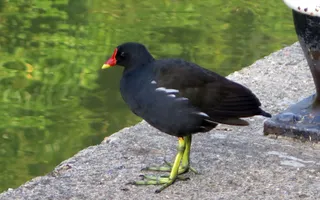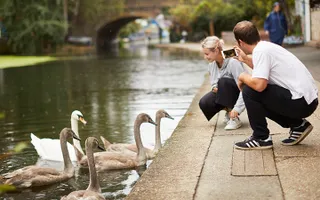Often seen hovering above fields and verges, kestrels are a common bird of prey with the unmatched ability to suspend in mid-air.
How many kestrels are there in the UK?
Despite a decline in the late 20th century, populations remain steady. Kestrels are one of our most common birds of prey, with 31,000 breeding pairs in the UK. You won't have to go far to see a kestrel hovering above our canals or river navigations.
How can I tell the difference between a kestrel and other falcons?
The kestrel's expert ability to hover distinguishes them from other falcons.
This rare characteristic is made possible by the kestrel's fanned tail which helps them stabilise in the air. Buzzards can also hover, but not as gracefully.
Male kestrels have blue-grey heads with dark triangles beneath the eyes and a light brown chest with black flecks. They also have sharper wing tips than other falcons.
4 tips to see kestrels
Kestrels are relatively common and widespread, and incredibly adaptable. Living in a variety of habitats and landscapes, there are plenty of opportunities to see kestrels on our canals. Here are our top tips.
1. Choose your moment
To spot a kestrel, you should head out in the mid-morning. They're most active during the heat of the day.
2. Head to their habitat
Kestrels tend to fly in open spaces with long grass where their preferred food – field voles – live. You might also find them along woodland edges, above roadsides and canal verges or perched on fences or lampposts.
They hunt in similar habitats to owls, and sometimes steal their prey. While out on walks, keep an eye out for kestrels hovering above.
3. Look for hovering birds
The tell-tale hovering behaviour of kestrels is their most distinctive characteristic. If you see a falcon hovering above, it's likely a kestrel.
4. Listen for their 'kee-kee-kee' screech
Although generally quiet birds, kestrels sometimes make a shrill 'kee-kee-kee' sound when they near their nests. Their calls vary. The kestrel will make a more spaced-out 'kee-kee' when alarmed and a more quick-fire sound when in flight.
How to identify kestrel pellets and feathers
One way to spot kestrels is to follow what they leave behind. For instance, if you find a kestrel's pellet or feather, there's a good chance that a kestrel has been hunting in the vicinity.
Kestrel pellets are around 2-4cm long and 1-2.5cm wide. Light grey in colour, they're round at one end and pointed at the other.
A kestrel's feather is striking. Males have grey tail feathers with a thick black band, while females have brown feathers with the same black band.










